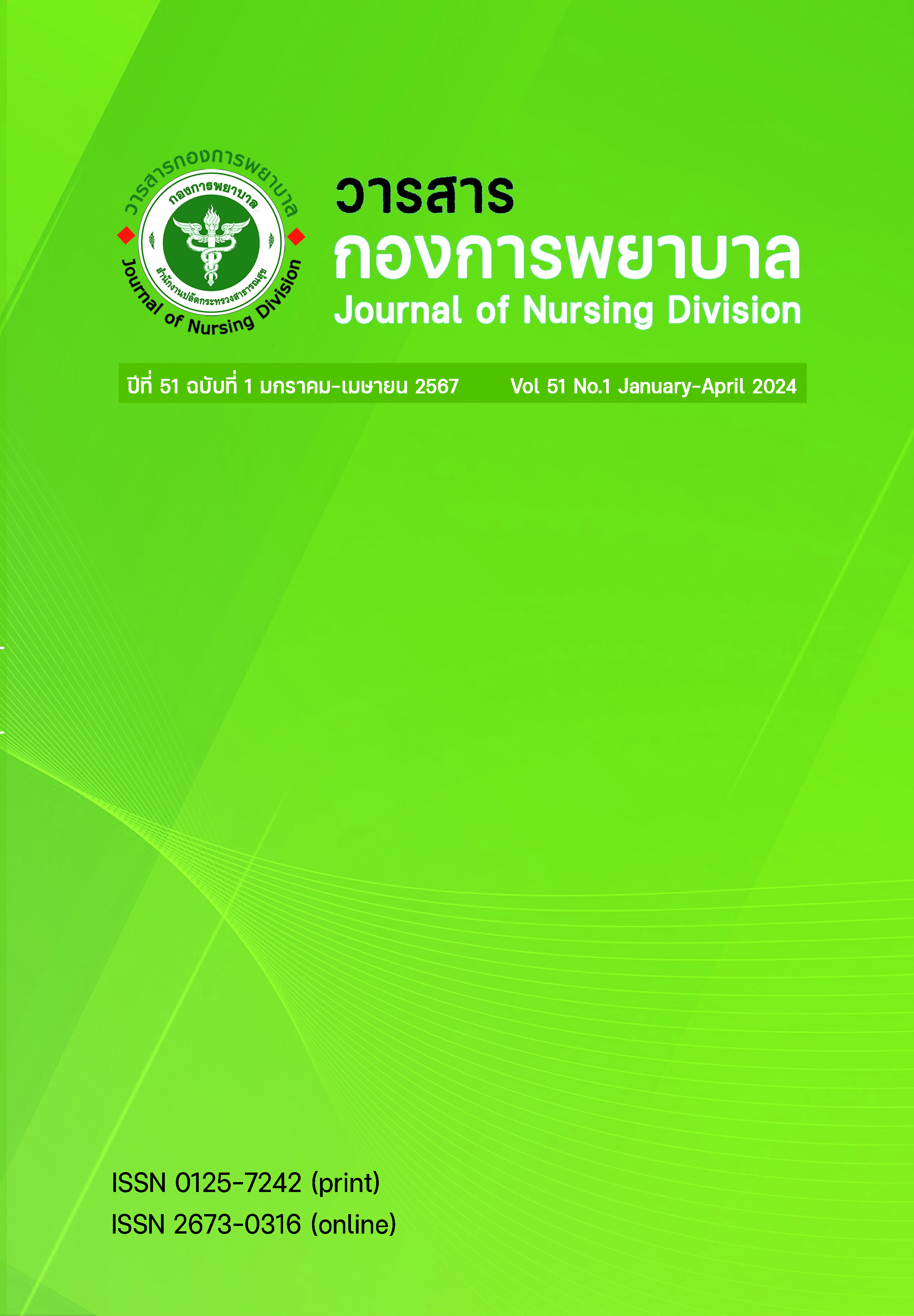การพัฒนารูปแบบการนิเทศทางคลินิกของผู้ป่วยที่ใส่เครื่องช่วยหายใจ ในหอผู้ป่วยหนักอายุรกรรม โรงพยาบาลหาดใหญ่
Main Article Content
บทคัดย่อ
บทคัดย่อ
การวิจัยและพัฒนานี้มีวัตถุประสงค์เพื่อพัฒนาและประเมินผลการใช้รูปแบบการนิเทศทางคลินิกของผู้ป่วยที่ใส่เครื่องช่วยหายใจ หอผู้ป่วยหนักอายุรกรรม กลุ่มตัวอย่าง ได้แก่ พยาบาลที่ปฏิบัติงานในหอผู้ป่วยหนักอายุรกรรม 32 คน แบ่งเป็น ผู้นิเทศ 10 คน ผู้รับการนิเทศ 22 คน และผู้ป่วยใส่เครื่องช่วยหายใจ หอผู้ป่วยหนักอายุรกรรม 580 คน แบ่งเป็นกลุ่มก่อนและหลังพัฒนา กลุ่มละ 290 คน ดำเนินการ 4 ขั้นตอน คือ (1) สำรวจสภาพปัญหาและความต้องการการพัฒนา (2) ศึกษาแนวคิด ทฤษฎี ความเป็นไปได้ และการออกแบบ สร้าง เลือกวิธีการ (3) ทดลองใช้และปรับปรุง และ (4) ประเมินผลการใช้รูปแบบ เครื่องมือการวิจัย คือ รูปแบบการนิเทศทางคลินิก เครื่องมือเก็บรวบรวมข้อมูล คือ แบบประเมินการนิเทศทางคลินิกของพยาบาลผู้นิเทศ แบบประเมินความสามารถการปฏิบัติการพยาบาลผู้ป่วยที่ใส่เครื่องช่วยหายใจ และแบบบันทึกผลการพยาบาล ดัชนีความสอดคล้อง (IOC) 0.86 0.87และ 0.88 ตามลำดับ ค่าสัมประสิทธิ์แอลฟาของครอนบาค 0.84, 0.86 และ 0.85 ตามลำดับ วิเคราะห์ข้อมูลด้วยค่าเฉลี่ย ส่วนเบี่ยงแบนมาตรฐาน paired t-test และ Mann-Whitney U test
ผลการวิจัย พบว่า การพัฒนารูปแบบการนิเทศทางคลินิกของผู้ป่วยที่ใส่เครื่องช่วยหายใจได้ ประกอบด้วย (1) แนวปฏิบัติการพยาบาลผู้ป่วยที่ใส่เครื่องช่วยหายใจ (2) คู่มือการนิเทศ (3) คู่มือการสอนงาน (4) คู่มือหลักและจริยธรรมทางการพยาบาล ผลการใช้รูปแบบการนิเทศทางคลินิกของผู้ป่วยที่ใส่เครื่องช่วยหายใจ พบว่า พยาบาลผู้นิเทศมีคะแนนความรู้และทักษะปฏิบัติการนิเทศทางคลินิก เพิ่มขึ้น (p < .001) พยาบาลผู้รับการนิเทศมีการปฏิบัติการพยาบาลผู้ป่วยที่ใส่เครื่องช่วยหายใจเพิ่มขึ้น (p < .001) และผลลัพธ์ต่อผู้ป่วย พบว่า อัตราการเกิดปอดอักเสบจากการใส่เครื่องช่วยหายใจลดลง (p < .001) อัตราการเกิดท่อช่วยหายใจเลื่อนหลุดลดลง (p < .001) อัตราการหย่าเครื่องช่วยหายใจ เพิ่มขึ้น (p < .001) และระยะเวลาในการใส่เครื่องช่วยหายใจเฉลี่ยลดลง (p < .001)
Article Details

อนุญาตภายใต้เงื่อนไข Creative Commons Attribution-NonCommercial-NoDerivatives 4.0 International License.
เอกสารอ้างอิง
Reference
Healthcare Accreditation Institute (Public Organization). Hospital and Health Service Standards, Edition 4. Nonthaburi: D-One Book; 2018.
Tana P, Kanokrat S, Trakulsithichoke S. Effects of clinical supervision on the application of nursing process in caring of diabetic patients and nurses’ satisfaction. Journal of Nursing and Health Care. 2017; 35: 52-60.
Statistics on indicators of medical intensive care units. 2023.
Ratchaneewan Chutrakul, Pitchayapan Chantra, Patcharee Yimyaem, Sureeporn Kumpaka, Ratchanee Namchantra. Development of a clinical supervision model for nursing care of patients with severe bloodstream infection syndrome. Journal of Cardio-Thoracic Disease. 2019;30(2): 193-209.
Proctor B. Training for the supervision alliance attitude, skills and intention, in J.R. Cutcliffe T. Butterworth and B. Proctor (ends), Fundamental Themes in Clinical Supervision, London: Routledge. 2001; 25–46.
Chanpen Niamwan, Dueanram Rueangsaen and Warathip Kaenkarn. The Professional Nurses’ Competencies in Nursing Patients Using Mechanical Ventilation. Journal of Nursing and Health Care. 2020 ;38(1): 16-14.
Chanpen Niamwan and Dueanram Rueangsaen. Competency in managing care for patients using ventilators. of professional nurses Nopparat Ratchathani Hospital. Vachirasan Nursing. 2018; 20(2): 1-12.
Alexander G. Behavioral coaching-the GROW model In Passmore, Jonathan.Excellence in coaching: The industry guide. (2nd ed.). Philadelphia: Kogan. 2010.
Niphada Tharipian, Thitinan Wattanachai, Monporn Chatchamni. Effectiveness of using the Patient’s Ventilator Care Protocol. Journal of Nursing and Health Care 2019; 37(1):70-79.
Sasithorn Bampenphon. The Effect of Clinical Supervision Model in Nursing Care Process for Nurse. Hua Hin Medical Journal. 2023; 3 (3)
Kanya Liankruea, Supaporn Payunmahisorn, and Sirikul Karuncharernpanit. The Development of Clinical Supervision Model for Ventilator Associated Pneumonia Prevention among the Intensive Care Unit in Phaholpolpayuhasaena Hospita. Journal of Roi Kaensarn Academi. 2022; 7 (9): 300-316.
Boonjai Srisathitnarakun. Nursing research methods. Bangkok: You &I Intermedia. 2012.
Rattana Buasan. Qualitative research in education, Bangkok: Chulalongkorn University. 5th edition. 2015.
Ruammek, L. (Producer). Clinical Supervision under nursing standards. General Meeting 2020 of Thailand Nursing Association. 2020.
Phongphan Thana, Kanokrat Saengampai, Suthisri Trakulsittitchoke. Effects of clinical supervision on the use of the nursing process in caring for diabetic patients. and nurse satisfaction. Journal of Nursing and Health Care. 2017;35(4): 52-60.
Mathuros Tantiwet, Areerat Khamyu and Pranom Otakanon. Development of a nursing supervision model for nursing inspectors outside of official hours. Buddhist hospital. Faculty of Nursing Journal Burapha University. 2017; 25(3)): 41-51.
Kanya Liankruea, Supaporn Prayoonramahisorn and Sirikun Karuncharoenphanit. Development of a clinical nursing supervision model to prevent pneumonia. from using a ventilator in the intensive care unit Phahonyothin Phonphayuhasena Hospital. Journal of Roi Kaensarn Academi. 2022; 7(9): 300-316.
Nonglak Kam Phatsorn, Suwinee Wiwatwanich. The results of Clinical supervision program for pressure sores of patients and their satisfaction with their supervision Professional nurse. Nursing Division Journal. 2016; 43(3): 44-58.
Michelle CG, Kerry JI, Deborash S. Education on invasive mechanical ventilation involving intensive care nurses: a Systematic review. Nursing in Critical care. 2018; 23(5): 245-255.


